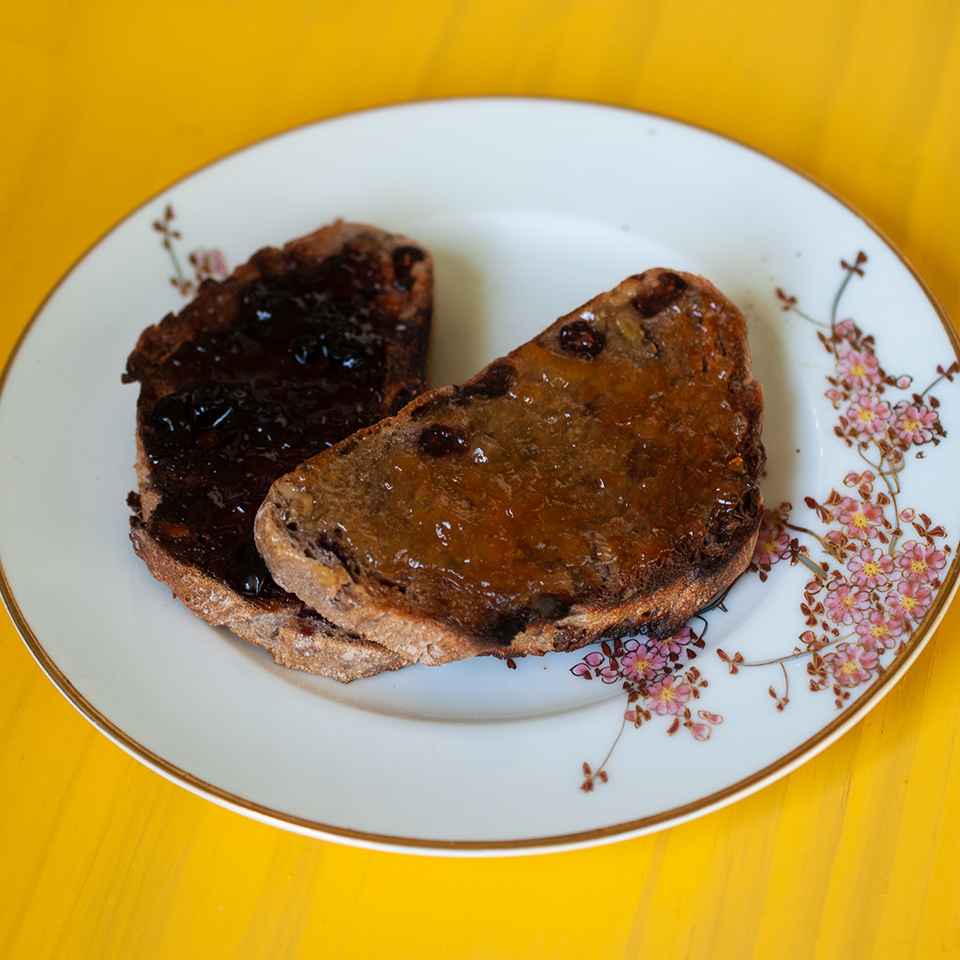
Jelly Time
what's the difference between jam and jelly?
Jellies. Jams. Preserves. Spreads. Marmalades.
What’s the difference? Is there a difference?
Jellies are made from strained fruit juice with no bits, pieces, seeds or pulp. The fruit juice is often enhanced with sweet apple juice or white grape juice, which add sweetness to the finished product but are so mild that they don’t overwhelm the original flavor, and usually refined sugar is added as well. The resulting juice blend is then boiled to reduce it – not only does this concentrate the flavor, but the sugars and pectins in the fruit naturally thicken and set. Sometimes additional pectins and cornstarch are added to ensure a consistent product. A good jelly should be translucent to the point where you can see right through it, and should only have the natural color of the juice used to make it.
Jams are made using a similar process. The prime difference between jellies and jams are that jams are made with whole fruits that have been smashed or muddled, and are not filtered to remove particulates and chunks. Jams may be translucent, but you’re not going to be able to see through them.
Preserves are made from whole fruits, or at least large pieces of fruit. They are boiled to become soft, but are not mashed or macerated. (Smaller fruit chunks and berries will often lose their shape, so there’s little difference between, say, strawberry jam and strawberry preserves.) The resulting product is chunky and still somewhat translucent? But not always.
Fruit spreads are also made with whole fruits, but no refined sugar is added during the process – only other fruit juices. They are usually opaque.
Compotes are a type of fruit preserve made from whole fruit, or chunks of fruit, which are soaked in a simple sugar syrup for several hours then slowly cooked. They are often seasoned with spices and a dash of liquor, and sometimes thickened with additional pectin. The fruit in a good compote retains the majority of its original shape – a good example would be the peach topping on a Peach Melba. (Use cling peaches right from the can if you must, but know that you’re doing it wrong.)
Fruit butters are made from slow cooked fruit. The fruit is boiled until it is soft and tender, then puréed and left in a specialized jelly straining bag to remove any excess liquid. At this point spices might be added to the mix, along with sugar, honey, or any number of other sweeteners. The puréed fruit is then cooked again at a low temperature for several hours, evaporating more excess liquid. During the process the sugars and other compounds oxidize and caramelize, darkening the finished purée. The end product has a consistency like soft butter.
Marmalades are preserves made from citrus fruit, where pieces of the peel are added to the juice, sugar, and water as they boil down. The pulp of citrus fruits contains large quantities of natural pectin, so additional water is added during the process. The end product is similar to jelly, but the chunks of rind make it chunky like a jam while imparting additional flavor and fragrance. The earliest marmalades were made from quinces stewed in honey – in fact, the modern word marmalade is derived from the Portuguese marmelada, which just means “quince preparation.” These days they’re mostly made from oranges. Other, non-citrus fruits can also be made into marmalade – though these days, it’s rarely done. Every country has different rules and regulations on what can be used to make marmalade – in Britain and Canada the guidelines are extremely strict about what goes into marmalade, while the rules here in the United States are a little looser.
There are many different marmalade variations, including thick cut marmalade with large pieces of peel, imparting a tangy and bitter flavor; thin cut marmalade with fine pieces of peel that has a milder flavor and texture; black marmalade which is enhanced with brown sugar or molasses; vintage marmalade that is set aside to mature and develop flavors; and flavored marmalades with added flavors including different types of citrus rind, spices, and sometimes booze.
There are other ways to make fruit and vegetable spreads. Freezer jams are popular – I recently had a friend tell me about a zucchini jam she was making, a mixture of cooked zucchini and pineapple, using Jello as a thickener. Because freezer jams often use substitutes like gelatin as a thickener, they are not shelf-stable and therefore not true jams or jellies. Still delicious, though.
You don’t really need to know the minute differences between various fruit spreads to enjoy them. Let who you are determine your choice. Can’t stand lumps? Suffering from diverticulitis and can’t have seeds? Go for jelly. Other than that, pick a flavor you enjoy. It’s all good. They’re all delicious sweetened fruit, in a preparation that lasts longer than fresh fruit, which enables you to use it in any number of wild and wonderful ways from elaborate sauces to just slathering it on toast.
So let’s go get our jam on. Or jelly. Or preserves.
The last time we did a food episode – Series 9’s “Crunchy or Wrong,” which was about peanut butter – we ended with a taste test of various peanut butters conducted by our international flavor expert, #6. We figured it was only fair to do the same for peanut butter’s eternal companion, jelly. (For sanity’s sake, I did not attempt to transcribe this. You’ll have to actually listen to the episode to hear it.)
Sources
- McGee, Harold. On Food and Cooking: The Science and Lore of the Kitchen (second edition). New York: Scribner, 2004.
- Montagne, Prosper. Larousse Gastronomique. New York: Crown Publishers, 1961.
Categories
Tags
Published
First Published:
Last Edited:


